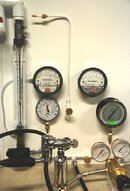It used to be that the technician tuning a G250 could play a role in WOB by how he/she adjusted the VIVA venturi vane. This was before SP shifted to a Pre-Dive/Dive knob.
That vane plays a key role in whether the WOB curve follows its ideal path just greater than zero inspiratory effort, or whether poor vane position creates such turbulence that inspiratory effort actually rises with high respiratory flow. Conversely, a vane tuned too "loose" allows such negative pressure inside the regulator case due to air flow Venturi effects, that the pull on the diaphragm becomes greater than your inspiratory effort and shifts the regulator into freeflow. These two effects become more pronounced at depth, with "thicker" air.
Regulator case design has now become sophisticated enough that manufacturers are able to design in features that enable minimal breathing effort due to Venturi assist without crossover. The trouble is, you don't know what you may or may not be getting without testing. More important, what used to be a specific adjustment to optimize flow is now "on or off", even if a vane position at depth slightly less than "full on" might be better at preventing freeflow.
Pete Wolfinger's technique as detailed in Regulator Savvy remains within the reach of a good shop, but since there's no money in it, very few shops will do it. But for the geek, you can build a dynamic flow device that allows you to plot inspiratory pressure against flow, to see just how your reg performs.
Here's a sample plot from an old G250.
The two lines show the extremes of vane position. The squiggly line shows the prevention of crossover that occurs with a slight tilt of the vane toward the predive position.
While these flows are not normally encountered even with vigorous breathing effort, they may approximate reg performance at depth, where thicker air means higher numbers of molecules passing thru the case, somewhat similar to high flow at one atmosphere.
Scubatools offers a flow bench for $1,100 after tax and shipping. I built this one for ~$250 from individual parts off Amazon, eBay and the hardware store:





